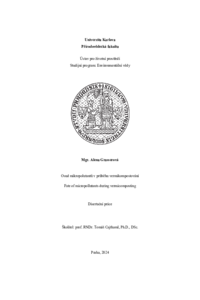Osud mikropolutantů v průběhu vermikompostování
Fate of micropollutants during vermicomposting
rigorous thesis (RECOGNIZED)

View/
Permanent link
http://hdl.handle.net/20.500.11956/189204Identifiers
Study Information System: 270657
Collections
- Kvalifikační práce [20088]
Author
Faculty / Institute
Faculty of Science
Discipline
Environmental Protection
Department
Institute for Environmental Studies
Date of defense
6. 5. 2024
Publisher
Univerzita Karlova, Přírodovědecká fakultaLanguage
Czech
Grade
Recognized
Keywords (Czech)
Mikropolutanty, vermikompostování, endokrinní disruptory, farmakaKeywords (English)
Micropollutants, vermicomposting, endocrine disruptors, pharmaceuticalsVermikompostování se v posledních letech stává populární přírodě-blízkou metodou používanou ke zpracování biologického odpadu, včetně čistírenského kalu. Ten je díky svým vlastnostem záhodno využít jako hnojivo na zemědělskou půdu. Kromě cenných prvků ale kal obsahuje i polutanty, jež po jeho aplikaci na pole mohou být přijímány rostlinami a živočichy a kontaminovat tak potravní řetězce. Do skupiny polutantů nacházejících se v kalu spadají i mikropolutanty, látky vyskytující se napříč životním prostředím v nízkých koncentracích. Mezi mikropolutanty se řadí například farmaka a produkty osobní péče, per- a polyfluorované látky nebo pesticidy. Tyto látky mají mnoho známých nežádoucích účinků, jako je endokrinní disrupce, antibiotická rezistence či rozvoj některých typů rakoviny. Ačkoliv hnojení čistírenskými kaly je jednou z hlavních cest vstupu mikropolutantů do životního prostředí, koncentrace mikropolutantů v čistírenských kalech nejsou před jejich aplikací na půdu nijak sledovány ani regulovány. Tato disertační práce se zabývá osudem mikropolutantů v průběhu vermikompostování, a to především čistírenských kalů jako substrátu. Vermikompostování bylo aplikováno za účelem stabilizace kávové sedliny a čistírenských kalů z různých čistíren odpadních vod smíchaných se slámou. Experimenty probíhaly v...
Vermicomposting is recently becoming a rather popular environmentally friendly technique for stabilizing biowaste, including sewage sludge. There is an effort to utilize the sewage sludge as fertilizer on agricultural land. But apart from nutrients, the sludge also contains harmful pollutants, which subsequently after its deposition on fields can be taken up by plants and organisms contaminating the food chains. Micropollutants, the substances that can be found throughout the environment in trace concentrations, are one of the pollutants occurring in sludge. It is for example pharmaceuticals and personal care products, per- and polyfluoroalkyl substances, or pesticides. Their negative effects are known - they can be for instance endocrine disruption, antibiotic resistance, or the development of cancer. Although the deposition of sewage sludge on fields as a fertilizer is one of the main introduction routes of micropollutants to the environment, the content of micropollutants before deposition is not monitored nor regulated. This dissertation focuses on the fate of micropollutants during vermicomposting, especially in sewage sludge substrates. The vermicomposting method was applied to stabilize coffee spent grounds and sewage sludge obtained from distinct wastewater treatment plants mixed with...
